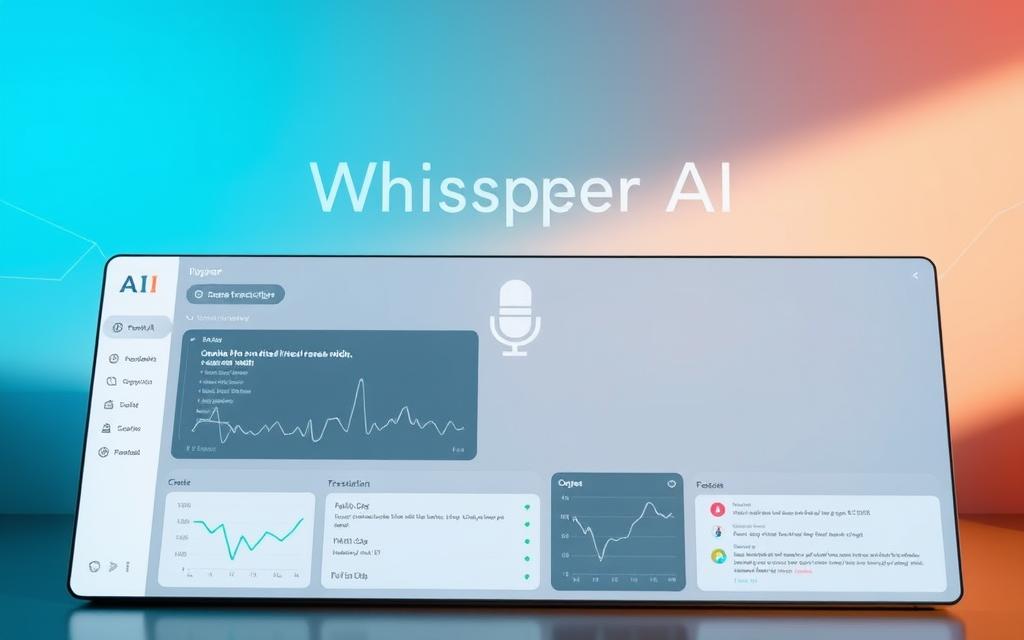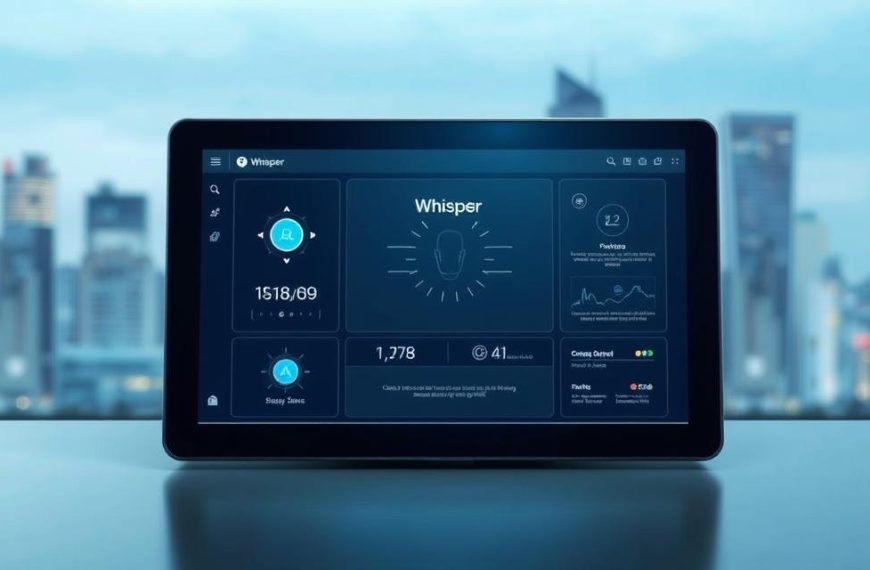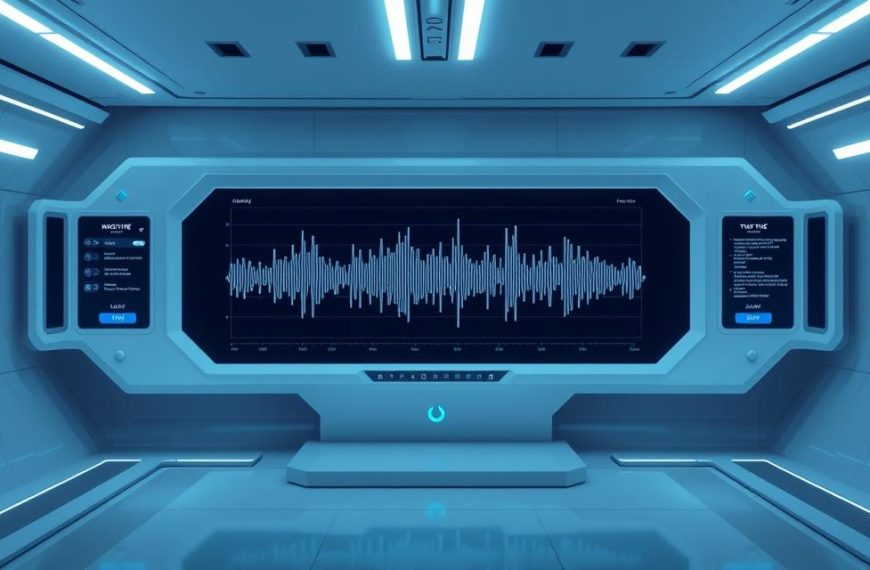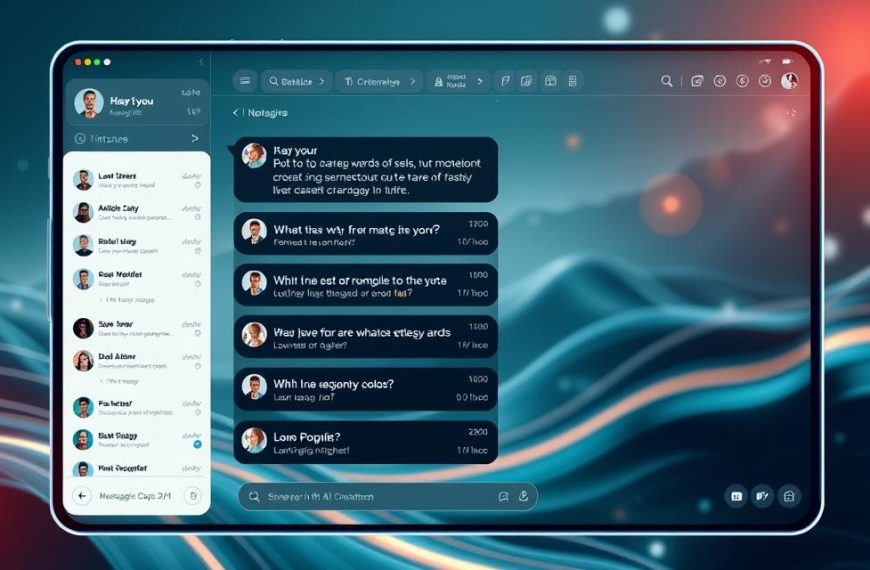OpenAI has made a big step forward in audio processing with its latest innovation. This advanced system is very good at handling different audio tasks. It works well in many languages.
The model’s design lets it handle a wide range of audio content. It’s a complete solution for audio challenges that experts face every day.
This technology stands out because it can do many things at once. It can recognize speech, translate languages, and identify spoken languages in audio files all at the same time.
The model was trained on a huge dataset of different audio samples. It shows high accuracy in real-world use. Its design makes it useful for both business and research.
This new approach to speech recognition sets high standards for automatic transcription. It works well with various accents and audio conditions. This makes it very useful for companies working globally.
What Makes Whisper AI Revolutionary
Whisper AI is changing how we understand speech. It’s more accurate and flexible than old systems. It can handle different accents and background noises with ease.
The Transformer Architecture Powering Whisper AI
Whisper’s strength comes from its transformer model. It’s made for tasks that involve sequences. This neural architecture turns sound into text.
First, it changes raw audio into Mel spectrograms. These show sound frequencies over time. Then, it uses sinusoidal positional embeddings to grasp the audio’s temporal aspects.
Training Methodology and Extensive Data Corpus
Whisper’s success comes from its huge training data. It was trained on 680,000 hours of labelled audio. This data includes:
- 117,000 hours in 96 non-English languages
- 125,000 hours of translation data between languages
- Content from various domains and contexts
OpenAI made sure the data was top-notch. They used standardisation and deduplication. The model learned from labelled and internet data, making it ready for real-world use.
Multimodal Capabilities Across Languages
Whisper can do many speech tasks at once. It uses special tokens for different tasks. This lets it switch between tasks smoothly.
It can transcribe, translate, and identify languages in one go. Whisper can handle speech in many languages. It picks the right task based on what it hears.
Check out this in-depth look at Whisper’s features. It shows how Whisper’s unified approach makes it more efficient and accurate.
Core Features of OpenAI’s Whisper AI
OpenAI’s Whisper AI is a big step up in speech recognition. It sets new standards with its performance. It works well for many professional uses.
Unparalleled Transcription Accuracy
Whisper AI has transcription accuracy that’s unmatched. It uses advanced neural networks and lots of training. This results in 10-20% fewer errors than before, in many languages.
It shines in tough settings too. Whisper handles background noise, different accents, and technical terms well. These are areas where other systems often struggle.
Its algorithms look at audio in a smart way. They understand whole phrases and sentences better. This cuts down word error rates a lot.
Real-Time Processing Capabilities
Whisper’s real-time processing is perfect for live use. It uses a 30-second window to balance speed and accuracy.
For longer audio, Whisper breaks it into chunks. This keeps the transcription smooth and accurate. It’s great for long conversations.
Whisper is fast, with almost no delay. This makes it great for live captioning and translation. It’s perfect for situations where speed matters.
Comprehensive Multilingual Support
Whisper supports an amazing 99 languages. It can detect the language spoken and adjust its processing. This is a big deal for global communication.
While accuracy varies by language, Whisper does well even in less common ones. This makes it a global tool.
Whisper not only transcribes but also translates into English. This is super useful for international business and making content local.
Check out our detailed Whisper AI overview for more. Its ability to handle different audio conditions makes it reliable for professional use.
Practical Applications Across Industries
Whisper AI brings real value to many professional fields. It offers advanced transcription features. This technology is used in healthcare, entertainment, and more to make work easier and services better.
Professional Transcription and Documentation
Whisper AI is a big help in the legal and medical fields. Law firms use it for accurate transcripts. Medical practices use it for patient records and notes.
Academic researchers benefit from transcribing interviews. Business teams use it for meeting notes. Its skill in handling specific terms makes it key for professional transcription services.
Accessibility Solutions and Closed Captioning
Whisper AI is great for making communication inclusive. Schools use it for live captions in lectures. TV companies use it for subtitles on live and on-demand shows.
It helps those who are hard of hearing to join in digital talks. Video calls now have automatic captions thanks to Whisper. This is a big step forward in accessibility technology for equal access to info.
“Speech recognition technology has transformed how we approach accessibility in digital spaces.”
Content Creation and Media Production
The entertainment world uses Whisper AI for many tasks. Podcast makers get accurate transcripts for their shows. Video makers add subtitles in many languages for global audiences.
Audiobook publishers work faster with automated transcription. Social media creators add captions quickly. Whisper’s role in media production is clear.
It makes localising content easier with accurate translations. Documentary makers record interviews more accurately. It helps creative teams at every stage.
Customer Service Enhancement
Contact centres use Whisper AI to improve customer service. It transcribes calls live to help agents. Teams that speak many languages get accurate translations.
Voice systems work better with better speech recognition. Analyzing customer feedback is easier with automated transcription. This leads to happier customers and more efficient work.
Financial and retail sectors use it for recording and analysis. It helps improve customer service. The use of Whisper AI is growing as it gets better.
Advantages Over Conventional Speech Recognition
Whisper AI is a big step up from old speech recognition systems. It works much better, even in tough audio situations. This makes it stand out from the usual solutions.
Exceptional Performance in Noisy Environments
Whisper AI is trained on many different audio types. This makes it very good at ignoring background noise. It keeps focusing on the main speech sounds.
This is really helpful in places where it’s hard to hear clearly. Like busy public areas, loud offices, or outside. Now, these places don’t stop Whisper AI from getting things right.
It can handle lots of conversations at once and sudden loud noises. This is a big improvement over old speech recognition tech. People get better results, no matter what’s going on around them.
Superior Handling of Diverse Accents
Old speech recognition systems often struggle with different accents or non-native speech. Whisper AI is different. It’s been trained on lots of different audio from all over the world.
This means it can understand many different ways of speaking. It’s good with British accents and international English, keeping its accuracy high. This is true for many languages, not just English.
It’s really good with people who speak English as a second language. It can pick up on small differences in how they speak. This is something old systems often get wrong.
Robustness Across Different Audio Qualities
Audio quality can vary a lot in real life. From high-quality studio recordings to low-quality voice messages. Whisper AI works well with all kinds of audio.
It can handle recordings that are low in quality, or have been compressed. It doesn’t need a lot of preparation like old systems do. This makes it very flexible.
Whether it’s dealing with clear recordings or ones that are not so good, Whisper AI gets it right. This makes it great for lots of different uses without losing quality.
Whisper AI is a top choice for anyone needing reliable speech recognition. It tackles the biggest problems that old systems face. It’s a big leap forward.
Implementation Strategies for Whisper AI
Organisations wanting to use Whisper AI need to focus on three key areas. These areas help ensure the technology works well and performs as expected. They are the foundation for adding Whisper AI to different work settings.
API Integration and Developer Resources
Whisper AI connects easily through various api integration methods. Developers can use the pipeline class for any audio length. This makes it great for both short clips and long talks.
OpenAI offers detailed guides and community help. The Hugging Face Transformers library is another way to use Whisper AI. There are also REST API options for different developer needs.
Python is the main tool for working with Whisper AI. You need a Python version between 3.8 and 3.11. This ensures it works well with important tools.
System Requirements and Infrastructure Planning
Knowing the system requirements is key for Whisper AI to work best. It supports six model sizes, needing from 1 GB to 10 GB of VRAM.
You’ll need PyTorch for deep learning and ffmpeg for audio work. These tools help with different audio types and qualities.
Planning your infrastructure is important. You need to think about how big your setup will be. Having the right GPUs is critical for speed and real-time use.
Check your current hardware against these needs. This helps avoid problems when you start using Whisper AI.
Customisation and Model Fine-Tuning
Whisper AI is very flexible with model fine-tuning. You can make it better for certain languages or tasks with just a little data.
Even with as little as five hours of labelled audio, you can improve it. This makes it easy for organisations with limited resources.
There are ways to make it faster, like torch.compile and Flash Attention. These keep the model’s quality but make it quicker.
Whisper AI can be made better for specific areas like healthcare or law. This means it can understand special terms and jargon.
By fine-tuning, you keep its ability to understand many languages. But you also make it better for your specific needs. This way, you get the best of both worlds.
Future Trajectory and Industry Implications
Whisper AI’s growth marks a big step in speech tech, affecting many areas. The November 2023 launch of Whisper Large V3 shows OpenAI’s dedication to bettering it. Yet, the model needs more testing in some specific fields.
Upcoming Features and Development Roadmap
OpenAI has big plans for Whisper AI. They aim to cut down on mistakes and add more languages. This will help the tech work better for people all over.
They’re also working on making it faster and linking it with other AI tools. This will lead to more advanced uses in various fields.
Impact on Speech Technology Standards
Whisper AI is changing how we measure speech tech’s success. It’s setting new standards for:
- How well it works in noisy places
- Speed and language support
- Helping people with different needs
This progress is making a big impact in fields like media and customer service. It’s pushing others to improve too.
Ethical Considerations in AI Development
Using advanced AI raises big ethical questions. There’s worry about privacy when it can listen in without asking.
There’s also concern about how it might be used for spying. Making sure it works well for everyone, without bias, is key. This needs ongoing work and careful thought.
It’s vital to use Whisper AI responsibly. We must make sure its benefits are worth the risks and that it follows ethical AI rules.
Conclusion
OpenAI’s Whisper AI is a huge step forward in speech recognition. It works well across many languages and different audio settings. This makes it very accurate and reliable.
The model is strong and can handle tough environments. Whisper does more than just transcribe speech. It supports many languages and works in real-time. This puts it at the leading edge of speech recognition.
Even though Whisper AI is very promising, it has some limits. It sometimes makes mistakes and doesn’t work equally well in all languages. These issues are key to understanding its current use.
Whisper is changing many fields, from helping people with disabilities to making new content. It makes customer service better and changes how media is made. This shows how versatile Whisper is.
As Whisper gets better, it will likely fix its current problems and do even more. It sets a strong base for the future of speech recognition. But, it’s important to use it wisely as it gets more advanced.


















